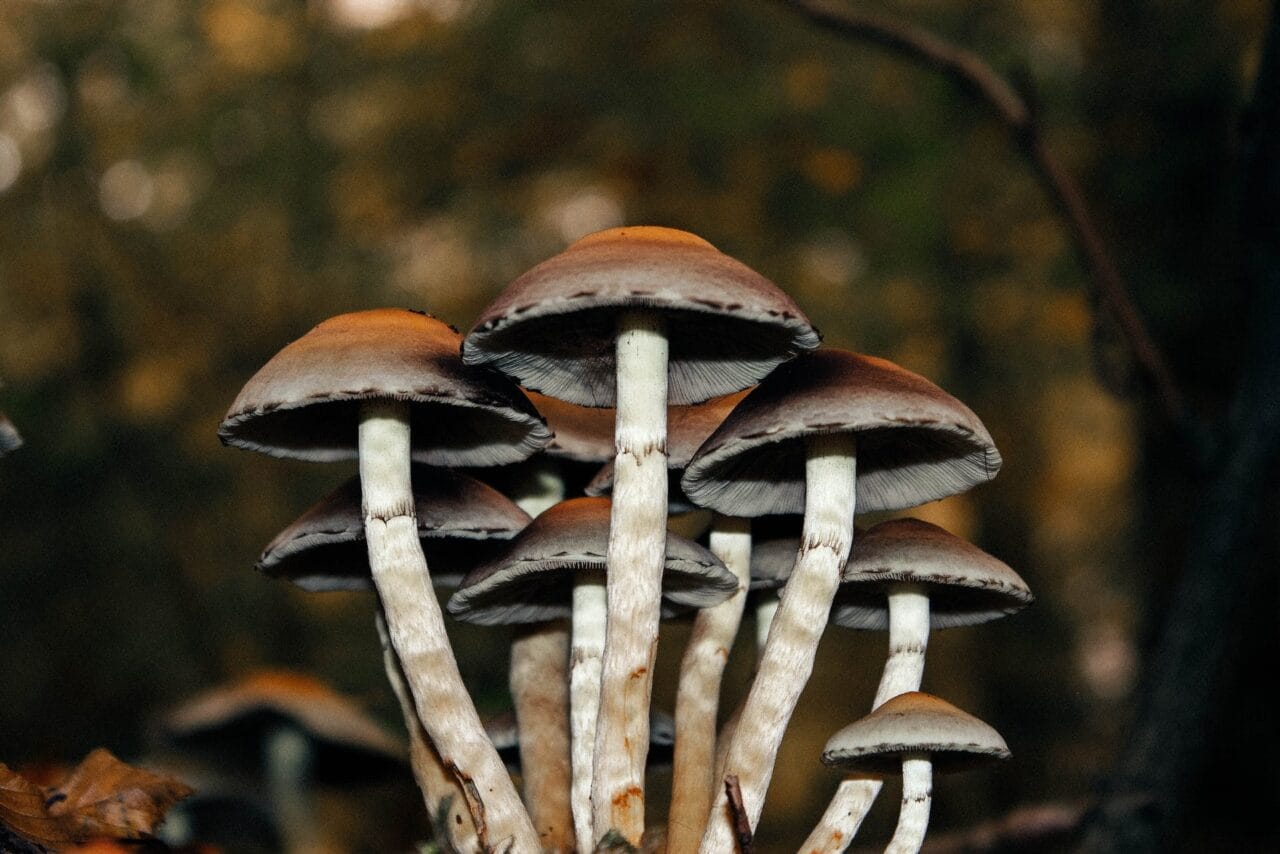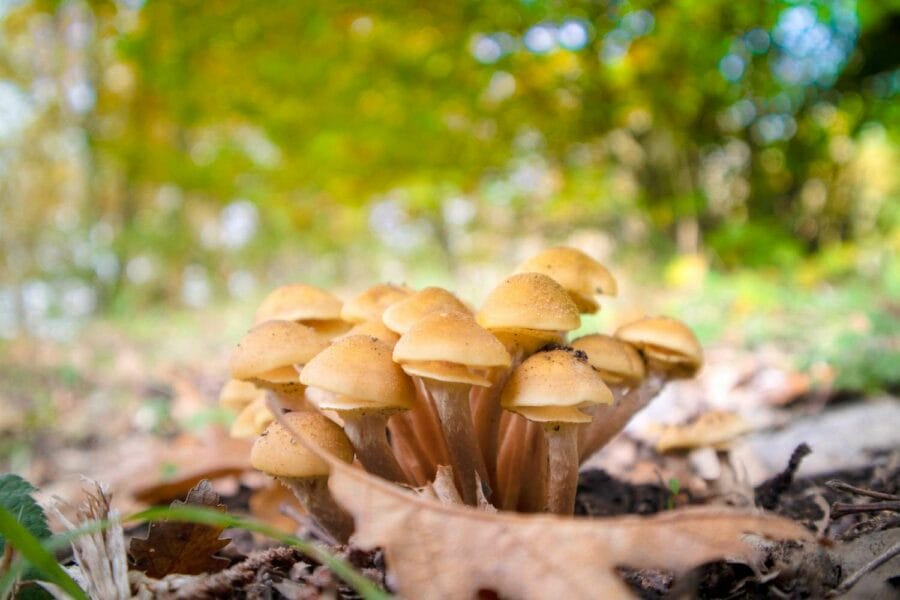Psilocybin, a psychoactive compound located in magic mushrooms, is commonly consumed recreationally to induce euphoria and hallucinations.
Beyond its mind-altering capabilities, psilocybin has been studied for its potential benefits in alleviating chronic pain.
This article provides a case study that investigates the potential of microdosing mushrooms in the management of chronic pain.
Key Takeaways:
- Microdosing mushrooms might offer immediate and sustained pain relief.
- In comparison to traditional pain medications, psilocybin microdosing typically has fewer side effects when used in small doses.
- Psilocybin works with the serotonin 2A (5-HT2A) receptors to alleviate pain, among other conditions.

The Study
Research titled “Microdosing Psilocybin for Chronic Pain: A Case Series” was carried out by Dr. Matthew Lyes and his team from the Division of Pain Medicine in the Department of Anesthesiology at the University of California, San Diego. Their study focused on three patients who self-administered low doses of psilocybin to control their chronic pain symptoms.
Three Patients, One Result – Reduction of Chronic Pain
Patient # 1
| AGE/ GENDER: | 37 Male |
| TYPE OF PAIN: | Neuropathic pain evident below the site of a spinal cord injury. |
| PAIN INTENSITY: | Initially 4 to 5/ 10, increasing to 8/ 10 later in the day |
| PSILOCYBIN DOSE: | 250 mg of crushed mushroom for less than 6 months |
| OUTCOME: | Discontinuation of prescribed pain medication, decrease in muscle spasms, and improved bowel movement efficiency. No signs of rebound pain or withdrawal symptoms. |
| The patient observed that while his standard medications only managed to lessen the pain, psilocybin effectively eliminated it, reducing his average pain level from 5 to 0. | |
Case Study Analysis: Patient #2
| AGE/ GENDER: | 69-year-old Female |
| PAIN TYPE: | Complex Regional Pain Syndrome (CRPS) |
| PAIN INTENSITY: | Typically fluctuating between 5 and 7 out of 10, with an increase during physical activity and pain surges |
| PSILOCYBIN DOSAGE: | 500 mg daily for 7 to 10 days with intermittent breaks (2 to 3 days) over the span of a year. Dosage augments to 750 mg to 1 gram during pain surges |
| OUTCOME: | 80% pain reduction for 3-4 hours, gradually reverting to original levels after 12 hours. Complete pain relief (90%-100%) persists for 6-8 hours, reverting to original levels after 18 hours. |
| The patient reports a diminished appetite without any accompanying nausea. Upon increasing the dosage (750 to 1000mg), instances of disorientation or walking instability are observed. | |
Case Study Analysis: Patient # 3
| AGE/ GENDER: | 40-year-old Female |
| PAIN TYPE: | Lumbar radiculopathy and neuropathic pain |
| PAIN INTENSITY: | Constant 8 out of 10, peaking to 10 out of 10 during physical activities |
| PSILOCYBIN DOSAGE: | 1000 mg derived from a mushroom chocolate bar every two months. |
| OUTCOME: | Significant pain relief without any psychoactive effects. Noticed improvement in flexibility and functionality. Pain gradually reverts to original levels over a span of 2-4 weeks. Recurrent dosage enhances pain management. |
| The patient does not identify any significant physical, cognitive, or behavioural side effects. Her mood remains predominantly stable. She maintains her standard SSRI dosage to manage depression throughout the psilocybin treatment period. | |
Deciphering Pain Management through Psilocybin
Constant somatic and visceral pain signals strengthen specific neural pathways due to peripheral and central sensitization, resulting in a persistent experience of pain, both physically and emotionally. Psychedelics such as psilocybin trigger 5-HT2A receptors, potentially recalibrating the brain areas involved in neuropathic conditions.
A patient reported enduring pain relief for several weeks. This suggests that post direct stimulation of the 5-HT2A receptors, a central regulation of pain perception and synaptic flexibility.
Possible Side Effects of Psilocybin Compared to Conventional Pain Relievers
| PSILOCYBIN (Based on Studies) | TRADITIONAL PAIN RELIEVERS |
| Muscular spasms | Nausea |
| Decreased hunger | Stomach discomfort |
| Disorientation | Headaches |
| Unsteady gait | Addiction risk |
| No mood changes | Drowsiness |
Potential Future Investigations on Psilocybin
The research team has identified potential areas of study for further investigation based on the experiences of three individuals which could present beneficial opportunities.
- Small doses of psilocybin could provide immediate and possibly enduring relief from neuropathic pain, without causing physical dependency or addiction.
- Research the effects of combining various treatment approaches with psilocybin. For example, one patient reported increased pain relief when psilocybin was combined with physical therapy.
- Small doses of psilocybin could provide pain relief even without psychotherapy, as evidenced in this case study. The researchers propose that integrating therapeutic guidance might enhance or extend the therapeutic outcomes.
Study Limitations
While the findings from the patients are encouraging, it’s essential to acknowledge the limitations identified in the study.
- The small sample size might not be representative of all individuals dealing with neuropathic pain.
- Subjects who did not respond to psilocybin were not included in the study.
- The effect of psilocybin on psychiatric disorders such as depression and anxiety was not evaluated before and after treatment.
- A lot of the data was self-reported by the subjects.
- The interviewer’s presence and potential biases related to psilocybin could have influenced the participants’ responses.
- The study didn’t investigate the potential influence of the placebo effect.
- The study did not determine the psilocybin content in each mushroom.
Exploring Microdosing with Mushrooms
This study involved patients Patients #1 and #2 consuming a microdose of psilocybin in a powdered form, which was extracted from dried mushrooms. Patient #3, on the other hand, combined it with chocolate. There are many products specifically created for psilocybin microdosing and we’ve gathered a selection of them for you below.
Dried Mushroom Varieties
The specific strain of mushroom used in the study was not mentioned, however, the one listed below is often recommended for those new to the practice.
- Golden Teacher: This strain is one of the most commonly found and widely recognized varieties of magic mushrooms.
- Amazonian Cubensis: This strain is known for its user-friendly nature and may offer cognitive enhancements.
- Cambodian: Microdosing with Cambodian cubensis mushrooms may boost concentration, social awareness, and mood.
Microdose Capsule Options
- Euphoria Psychedelics – Micro Calm Capsules: This concoction consists of Ashwagandha, Reishi, CBD, Valerian root, and Psilocybin Mushrooms, all of which have been scientifically demonstrated to alleviate anxiety and stress.
- Ground Sounds – Microdose Capsules – Champion Lover: This compelling blend provides three dosage choices: 50mg, 100mg, or 250mg of pure psilocybin combined with reishi, cacao, cordyceps, and maca.
- Kind Stranger – Brighten Capsules 250mg: These capsules incorporate the Golden Teacher strain, which is known for promoting mental clarity, enhancing creativity, and improving focus.
The Potential of Psilocybin in Pain Relief
Although the research on the analgesic properties of mushrooms is still in the preliminary stages, anecdotal reports and small-scale case studies are showing promising signs.
These instances underscore the necessity for more extensive research into the potential benefits of psilocybin, class=”wp-block-list”>
How long does the impact of a microdose last?
Typically, the effects of a psilocybin microdose can last anywhere from four to six hours. However, the overall benefits, such as improved mood and increased focus, can persist for several days.
Is it possible to microdose every day?
While it is physically possible to microdose daily, it’s not recommended due to the risk of developing tolerance, which may decrease the efficacy of the dosage over time. Most experts suggest following a schedule of one day on, two days off.
What are the potential side effects?
Side effects of psilocybin microdosing can include nausea, nervousness, and paranoia, though these are usually mild and temporary. If you experience any discomfort, it’s recommended to discontinue use and consult a healthcare professional.
Can you develop dependence on psilocybin?
Psilocybin is not addictive, and there is currently no evidence to suggest that it promotes dependence. However, regular usage should be undertaken with caution and mindfulness.
What are the legal implications of psilocybin use?
While there has been a shift towards decriminalization and research into psilocybin’s therapeutic benefits in recent years, it remains a Schedule I drug under federal law in the United States. It’s crucial to be aware of your local laws before considering its use.
What are the potential risks?
Psilocybin usage, like any other substance, carries potential risks. These include psychological distress, negative interactions with other substances, and potential legal ramifications. It’s important to approach its use responsibly and with the guidance of a healthcare professional.
What does the research say?
Clinical trials and research studies have shown promising results for the therapeutic use of psilocybin, particularly in the realm of chronic pain management.
Before the wider acceptance of psilocybin for pain relief, the positive reports from case studies instilled hope in those suffering from chronic pain.
Frequently Asked Questions
What are the effects of microdosing psilocybin?
Psilocybin’s primary effect is the activation of the 5-HT2A serotonin receptor in the prefrontal cortex, which produces two significant results:
- Stimulation of Brain-Derived Neurotrophic Factor (BDNF) production
- Enhanced Glutamate transmission
Moreover, psychedelics foster connections between brain regions that typically don’t interact as much. This unique connectivity is a result of psychedelics’ ability to decrease the activity of the Default Mode Network (DMN), which is involved in several cognitive functions, including daydreaming, introspection, and thinking about the past and future.
What is the most recognized benefit of microdosing mushrooms?
Microdosing could potentially enhance mood, productivity, creativity, and focus. However, its most well-documented benefit is its influence on mental health.
In November 2022, the mental health company COMPASS Pathways presented the findings of their comprehensive phase 2b trial, a randomized and double-blind study. Their research indicated that a single dose of psilocybin resulted in significant reductions in depressive symptoms compared to a placebo. Participants who received a higher dose of 25 milligrams showed a sustained antidepressant response at the twelve-week follow-up.
Additionally, a study published in the Psychiatry Research Journal suggested that psilocybin is more effective than traditional antidepressant treatments.
How can one determine their dosage?
Start with a 0.1-gram dose of psilocybin mushrooms on the first day. If the desired results are not achieved, you can gradually increase your dose by 0.05 grams on subsequent microdosing days until you find your ideal dosage.
Individuals with a history of using psychotropic drugs may need to increase the dosage to 0.5 grams to reach the desired effects.
What should be done before ingesting mushrooms?
- Set aside time to understand the reasons behind your decision to microdose on a particular day.
- Spend a few moments in self-reflection to identify your current emotional or mental state. Acknowledge the feelings or mindsets that you believe will be advantageous for you that day.
- Once you’ve clearly defined your goals, write them down. Expressing your objectives as affirmations can serve as a potent strategy for promoting your continuous growth.
- Direct your intention towards the experience you seek, rather than focusing on what you want to avoid.
- Take it on an empty stomach, preferably an hour before your first meal of the day.
What frequency is advised for consuming microdoses of mushrooms?
There exist several validated protocols that suggest structured microdosing routines for psychedelics. These protocols mainly differ in the number of “off” days they include, which are the days when you abstain from microdosing.
The most commonly suggested protocols recommend incorporating 1-3 rest days between microdoses. This aligns with the body’s natural tolerance mechanisms. The three protocols under consideration here are the Fadiman Protocol, the Stamets Stack, and intuitive microdosing.




